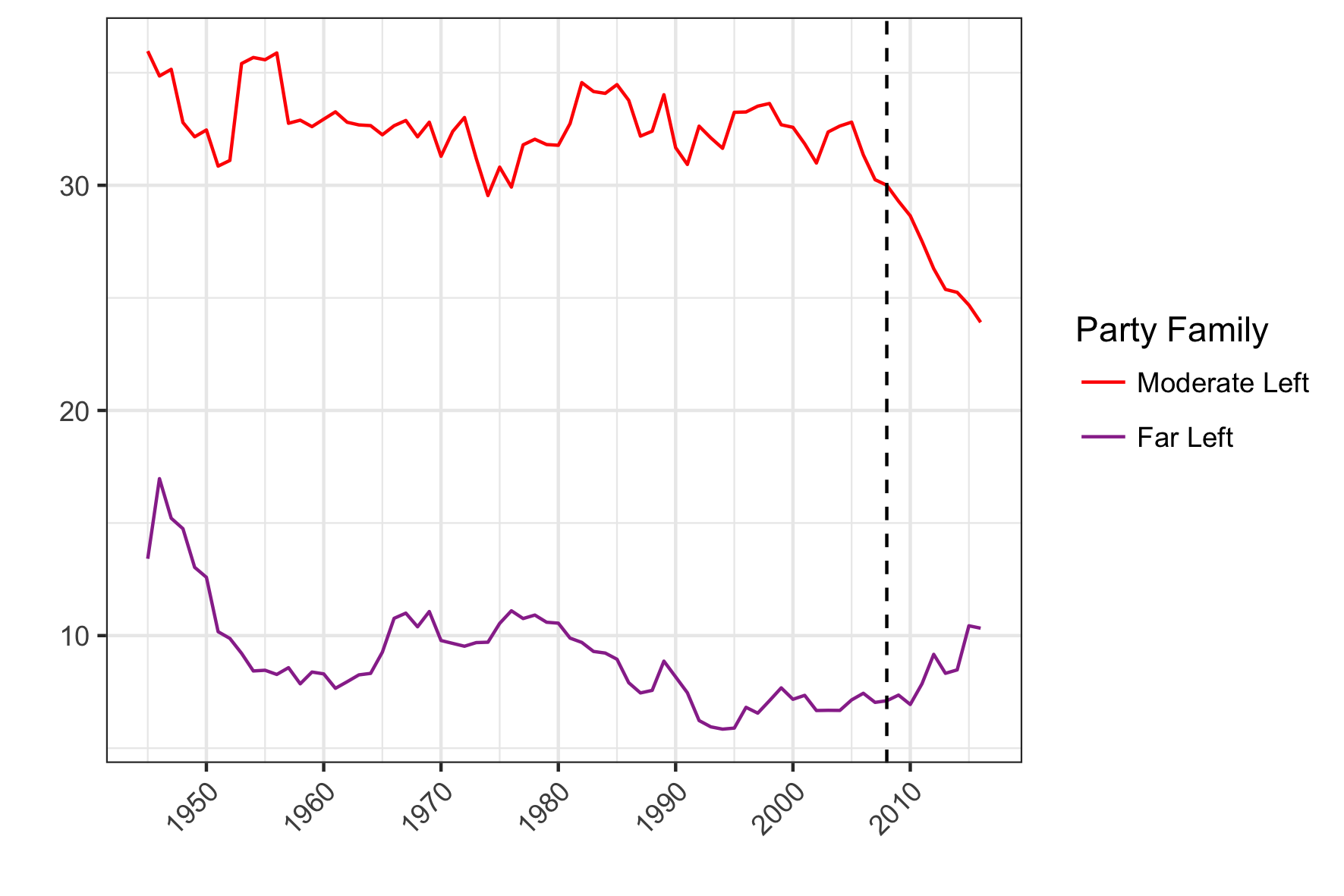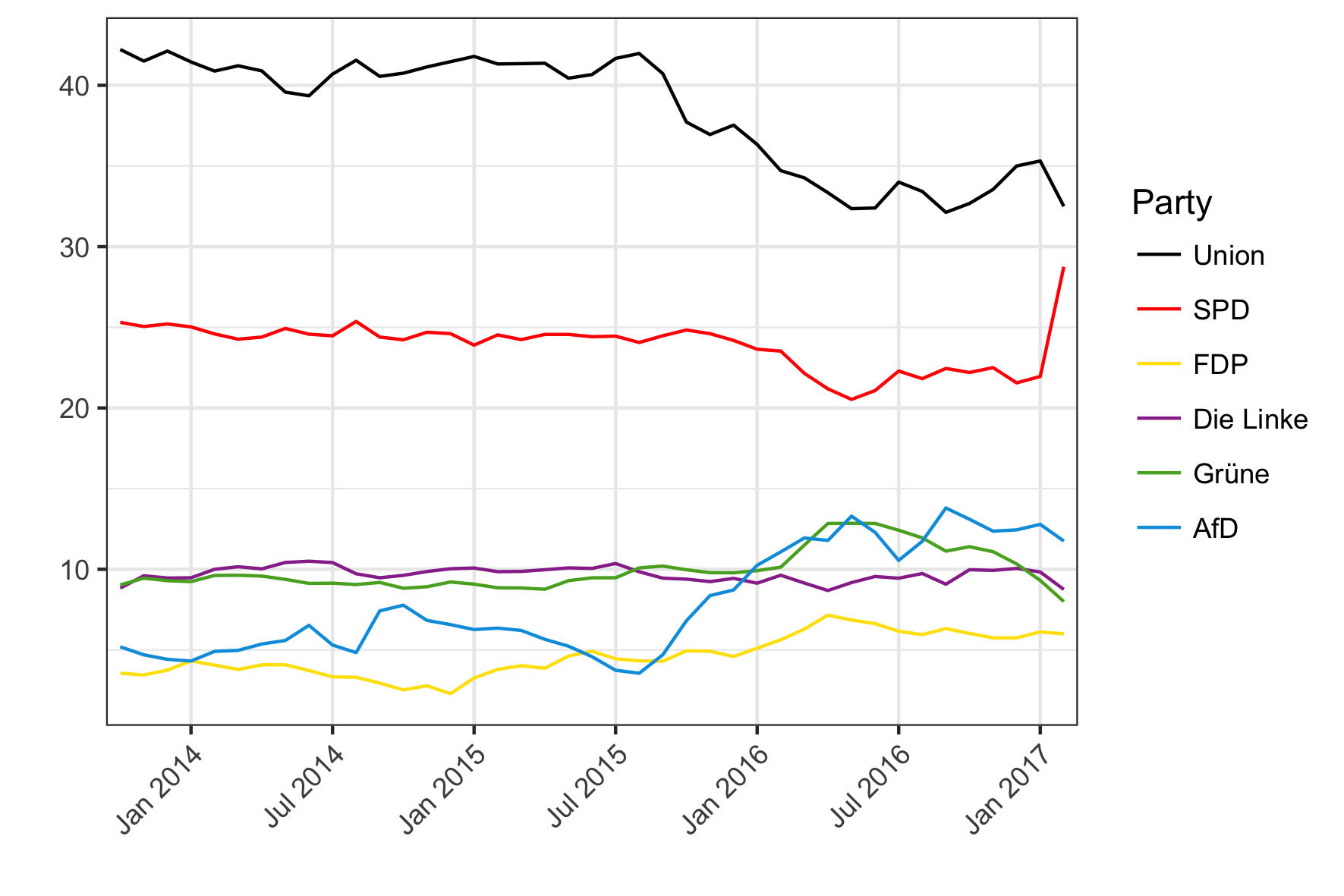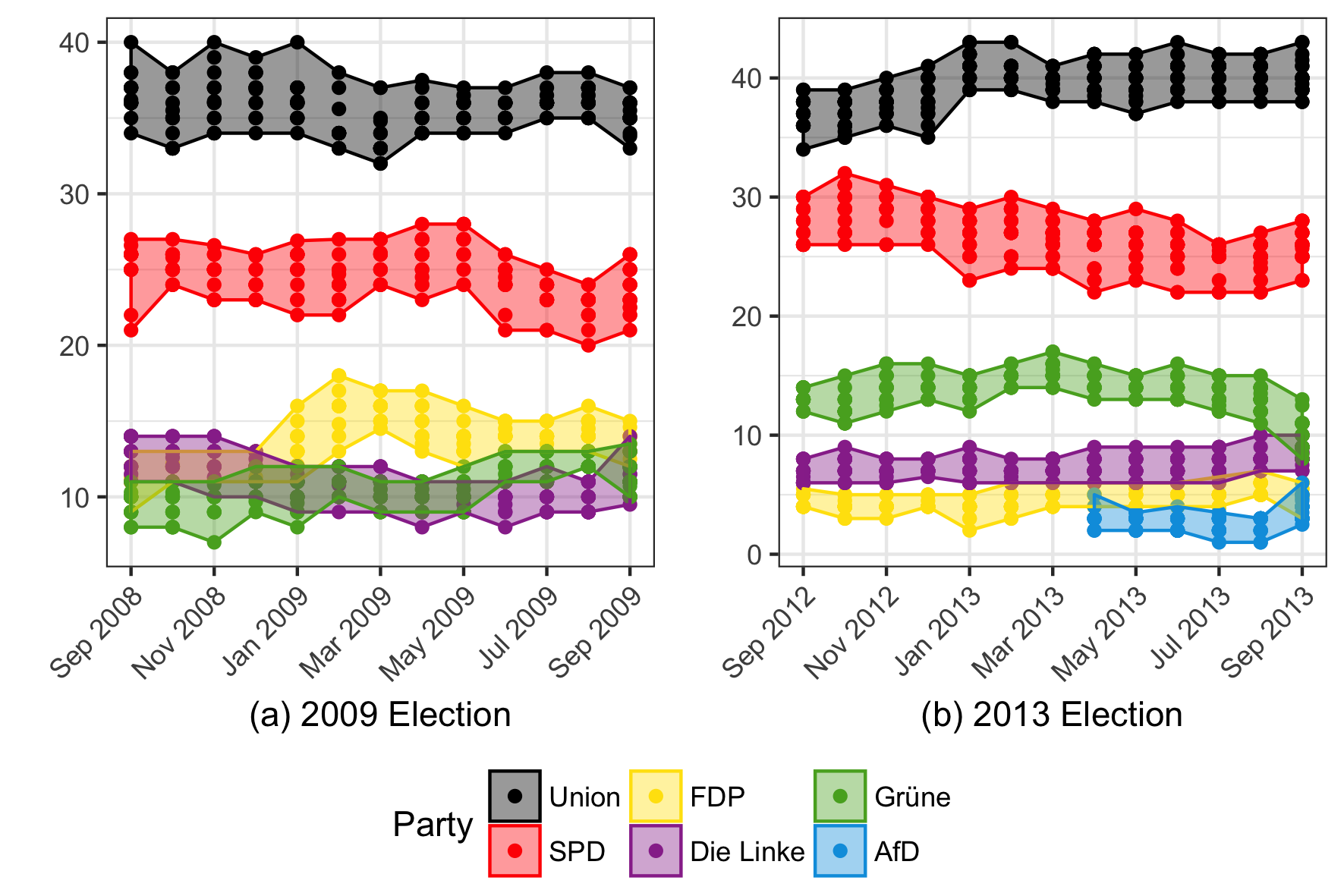Hope for Europe’s Social Democrats? Why Martin Schulz Might Reinvigorate the SPD but Struggle To Become Chancellor
Published:
The recent global economic crisis also led to a crisis of social democratic parties. Lacking clear ideas, the parties struggled to respond to the economic malaise and failed to be a strong political force in the context of the worst economic downturn since the Great Depression. As a result, the average vote share of social democratic parties in Western Europe dropped to an unprecedented low since 1945 (figure 1), leaving them at risk of sliding into political insignificance. In some countries, the far left benefited from this crisis of social democratic parties and much has been written about the causes behind the success of Alexis Tsipras, Jeremy Corbyn, or Bernie Sanders, who are spearheading these socialist insurgencies. However, except for Syriza in Greece, the far left failed to win elections and was unable to stop the wave of right-wing populism that is currently rolling across the Western world. At the beginning of 2017, commentators are instead looking to figures from the centre-left to stop this wave.
Figure 1: Average Vote Share of Left-Wing Parties in 17 Western European Countries since 1945

Source: ParlGov Database, own coding
In France, the former protégé of Francois Holland and now independent Emmanuel Macron has revived the hopes of the centre-left, even though the Socialist Party is mired in conflict after five disappointing years in power. Most recently, Martin Schulz, the former president of the European Parliament, has stepped up to become the new beacon of hope for the centre-left in Germany. Two weeks ago, the Social Democratic Party (SPD) announced that he would be the party’s chancellor candidate in the upcoming federal election in September 2017. Since then, a renewed sense of optimism has gripped the SPD. Several thousand new members have joined the party and in opinion surveys the party has jumped up by eight to ten percentage points, as seen in figure 2. A recent survey by INSA even put the SPD one percentage point ahead of the conservative CDU/CSU.
Figure 2: Monthly Average of German Opinion Polls since September 2013

Source: Various polling agencies
What are the Reasons for the Schulz Effect?
On the face of it, Martin Schulz is an unlikely candidate to the save the SPD from political insignificance. A member of the European Parliament for more than 22 years, he was a central pillar of the grand coalition in Brussels, which he cemented with his friend Jean-Claude Juncker after the 2014 European elections. Still, his main advantage is that he is a fresh face in Germany’s domestic political landscape. He is an outsider in Berlin, who is neither associated with the era of the last SPD-chancellor Gerhard Schröder, nor with the two grand coalitions led by Angela Merkel. Although he has been a member of the political establishment in Brussels for more than two decades, he did not play a part in the domestic struggles of the SPD. This frees Martin Schulz from some of the party’s historic baggage and will allow him to push the SPD onto a path of programmatic renewal.
Another reason that Martin Schulz is a promising candidate for the SPD is his ability to appeal to several distinct social groups. Socially liberal voters and especially young people are enthusiastic about his firm commitment to Europe and view him as the answer to the nationalist platform of the right-wing populist party Alternative für Deutschland (AfD). At the same time, Martin Schulz is also popular among the working class, the more traditional clientele of the SPD. He grew up and still lives in Würselen, a small town in West Germany that was historically dominated by coal mining. As the former mayor of that town, he is familiar with the challenges of structural change, but also embodies the American dream: without a university degree or even a high-school diploma, he defied the odds and became President of the European Parliament. This puts Martin Schulz in a very good position to strengthen the cross-class coalition between the working class and the post-materialist new Left, which social democratic parties rely upon but which has been fracturing in recent years.
What are the Challenges that Martin Schulz faces?
Despite the positive standing of Martin Schulz in opinion surveys, it remains uncertain whether his candidacy will pave the way for a SPD-led government. First, the recent failure of pollsters to accurately forecast election results in the US or the UK have cast doubt over the predictive power of polls in an age of political fragmentation. Moreover, prior to the last two German federal elections, public opinion was also volatile, as shown in figure 3. For example, at the beginning of 2013 the SPD received more than 30 percent of support in some polls, but eventually it only won 25.7 percent of the popular vote.
Figure 3: Variation in Opinion Polls in the 12 Months Prior to the Last Two German Elections

Source: Various polling agencies
Second, the fragmentation of political competition is still presenting the SPD with a difficult situation. On the one hand, Angela Merkel has firmly situated the CDU/CSU in the political centre and in the last few months her popularity ratings have recovered from the refugee crisis. According to some polls, she is nearly as popular as she was in early 2013, when the CDU/CSU won the election with a resounding 41.5 percent of the vote. On the other hand, the radical parties on both the left and the right end of the political spectrum are challenging the SPD. Die Linke is still supported by many people, who abandoned the SPD after Gerhard Schröder’s liberal reforms in the early 2000s. The AfD more recently attracted the support of former social democratic voters due to its Euro-sceptic and anti-immigration stance. Thus, political competition in Germany is pulling the SPD into different directions and it will be impossible for Martin Schulz to simultaneously appeal to the different constituencies that have abandoned the SPD.
Third, Martin Schulz’s status as an outsider in Berlin is not only an advantage, but also his biggest handicap. He does not have a large network of support in the capital and it remains to be seen whether he will be able to navigate the various lines of conflict within the political arena in Berlin and the SPD itself. Furthermore, many people still do not know what Martin Schulz stands for except for a deep commitment towards Europe. He was only marginally involved in the SPD-commission that was given the task to develop programmatic guidelines for the 2017 election and that published a discussion paper at the end of last year. The paper is expected to become the backbone of the party’s election programme, but Martin Schulz still needs to create a domestic profile and leave his own mark on the programme. Otherwise it will be difficult for him to both authentically represent the SPD and to set himself apart from Angela Merkel – two things that the SPD-candidates in 2009 and 2013 struggled to do.
Finally, even if Martin Schulz overcomes these challenges, he would still need coalition partners to form a government led by the SPD. Many people on the left – both inside and outside of Germany – are hoping that the SPD will finally be able to put together a ‘Red-Red-Green’ coalition comprising the SPD, Die Linke, and the Green party. Yet, Martin Schulz is not in the best position to build such a coalition because he comes from the ‘conservative’ wing of the SPD and his political contacts in Berlin do not reach far into other parties. Consequently, the Greens and Die Linke are uncertain what to expect from him and reacted cautiously after Schulz’s candidacy was announced.
However, the signs from Die Linke and the Greens are not necessarily encouraging for Schulz. Die Linke remains divided between a pragmatic faction that would like to join a coalition government and one that remains opposed to any collaboration with the SPD on the federal level. Until this day, it is not clear whether this internal conflict will be resolved by September 2017. Similarly, the Greens are split into two wings, but the recent election of Katrin Göring-Eckardt and Cem Özdemir as the party’s front-runners can be interpreted as a signal that the ‘pragmatic’ wing is gaining the upper hand within the party. According to the last polls, a coalition between the CDU/CSU and the Greens would not win a majority, but depending on the election result it is still more than a flickering possibility.
Will the Schulz Effect Be Large Enough?
In conclusion, it remains to be seen whether the Schulz effect will be large enough to end Angela Merkel’s dominance over the political landscape in Germany. While the SPD will benefit from his popularity and his ability to connect with people from very different backgrounds, the structural difficulties that social democratic parties have faced in Europe in the last few years still exist. The SPD has been torn apart by political competition and the party needs to be given a new, firm sense of direction with a clear programmatic position. As invigorating as Schulz may be, his popularity and a dash of European optimism alone will not be sufficient to win the election.
This post was first published on the WZB Democracy Blog. A slightly edited version was published by EuVisions.
